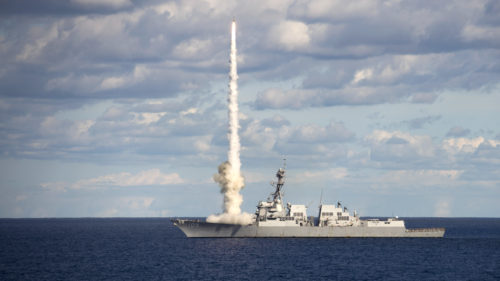Recent media coverage frequently portrays air and missile defense intercepts through the lens of a simplistic cost comparison: the expensive interceptor versus the seemingly cheap missile or drone it destroys. While such headlines grab attention, Wes Rumbaugh, a fellow at the Center for Strategic and International Studies, argues this approach paints an incomplete and potentially misleading picture. In a recent analysis, he delves deeper, urging a more nuanced understanding of the complex factors at play.

ATLANTIC OCEAN (Nov. 1, 2017) The guided-missile destroyer USS Jason Dunham (DDG 109) launches a SM-2 missile during a live-fire exercise. Jason Dunham is underway with the Harry S. Truman Carrier Strike Group preparing for future operations. (U.S. Navy photo by Mass Communication Specialist 3rd Zachary Van Nuys/Released)
Rumbaugh acknowledges the cost disparity between interceptors and their targets. Technical demands make interceptors inherently expensive, requiring exceptional speed, range, and guidance capabilities to successfully engage incoming threats. However, he emphasizes that focusing solely on this cost exchange ratio ignores crucial aspects:
- Operational realities: Defenders prioritize effectiveness over cost when engaging threats. While cheaper options exist, they may lack the range, area coverage, or capability to adequately protect larger areas or counter sophisticated threats like anti-ship cruise missiles.
- Value of defended assets: The cost of an interceptor pales in comparison to the value of assets it protects. In the Red Sea, air and missile defense safeguards vital commercial shipping lanes crucial to global trade. Similarly, defending military vessels like the USS Gravely, worth billions of dollars, justifies the use of more expensive interceptors despite cheaper alternatives.
- Strategic considerations: Air and missile defense serves broader strategic goals beyond individual interceptions. Protecting freedom of navigation and national sovereignty, like Ukraine’s defense against Russian aggression, carries immense intangible value that transcends dollar figures.
Rumbaugh doesn’t dismiss cost concerns. He acknowledges the importance of efficient spending and explores potential cost-saving measures within air and missile defense programs. However, he urges a shift in perspective: the primary goal isn’t minimizing financial expenditure, but rather achieving strategic objectives effectively. Evaluating air and missile defense solely through the lens of individual interceptor costs, he argues, provides an incomplete and potentially dangerous assessment.
By advocating for a broader understanding of cost, value, and strategic purpose, Rumbaugh invites a more informed and nuanced discussion on the crucial role of air and missile defense systems in today’s complex security landscape. This analysis serves as a valuable reminder that headlines only scratch the surface, and true evaluation requires deeper consideration of the multifaceted realities underpinning these critical defense systems.
For more information, hit the Source below